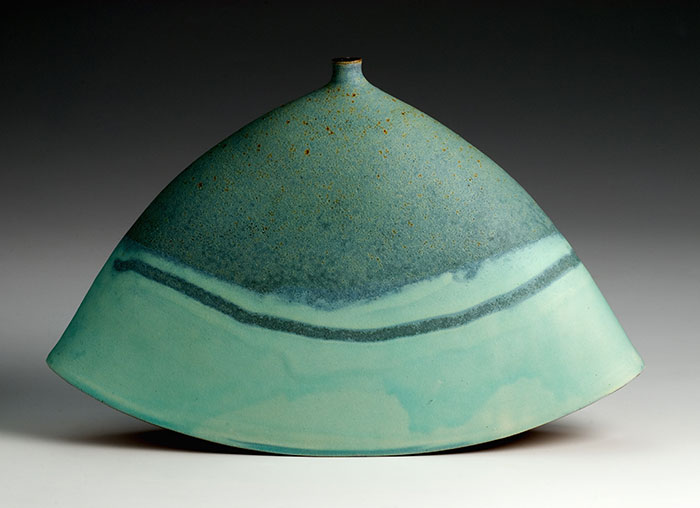Forms and vessels
Emily’s vessels take various forms, but all are very carefully controlled and although they feel organic, they often include elements that are geometric or even mechanical in nature.
Moon bottle
The form of the moon bottle is intended to be statuesque; the circle feature makes reference to Hepworth and Nicholson. The indented circle is achieved by coaxing in the clay with a wet finger and refining it further once almost dry.
It is important to be precise at this stage as the human eye is so good at discerning the slightest imperfection in the perfect circle.

Carved ball
The carved ball has become a signature piece for Emily Myers. This satisfying form makes reference both to furrows in ploughed fields and also to the precision of metal cogs. The green barium glaze and the sheen of the exposed red clay, perfectly complement the form.
Emily is often asked how she achieves such even lines, and the answer is: a steady hand and a good eye. She marks out the lines in segments before carving the pot. This time-consuming process has an almost meditative feel to it.

Ribbon vase
The flowing form of the ribbon vase is achieved by reshaping the thrown pot after it has had its base cut off at the leather hard stage.
The new shape is then reattached to a new ‘false base’ and left to dry out slowly to avoid possible cracking problems.

Faceted bottle
Faceting is a traditional technique seen in ancient Chinese ware and widely used by wheel based potters. The technique involves removing slices of clay from the outside of the pot to produce a multi-sided shape. Emily enjoys playing with the possibilities that this idea presents, and in particular adding an unusual twist to the facets. Some potters facet when the clay is wet, but Emily chooses the more controlled approach of faceting at the leather-hard stage.
The bottles are usually displayed in groups in order to establish a particular relationship between them. These groups evoke the quiet restraint in the paintings of Morandi.

Rocking pot
This unusual form, came about through experimenting with the idea of flattening vessels and to get away from the circular nature of the process. This piece starts its life as a dome, it has its base cut off and is then eased into its new flattened form.

“The effect is surprisingly light, in that the bottle is elevated and almost appears to float on the surface on which it stands. A small neck adds a point of focus to the seductive form, as do the range of matt glazes that Emily has developed.”Emmanuel Cooper
Lantern vase
This lantern vase makes reference to the clean restrained style of Keith Murray (a ceramic designer working in Britain in the 1930’s). It was thrown on a bat (a round wooden board that can be detached from the wheel head), left overnight to dry, and replaced on the wheel. The horizontal stripes were then created with a reductive process. One and two pence coins are held against the form, to achieve this precise and exacting effect.
